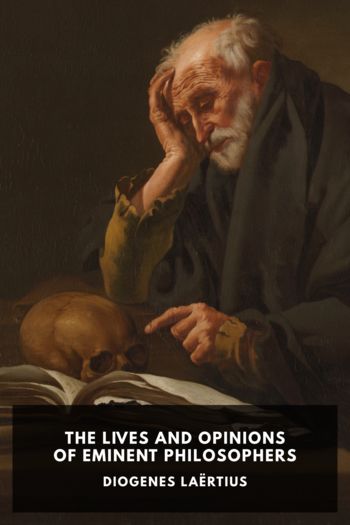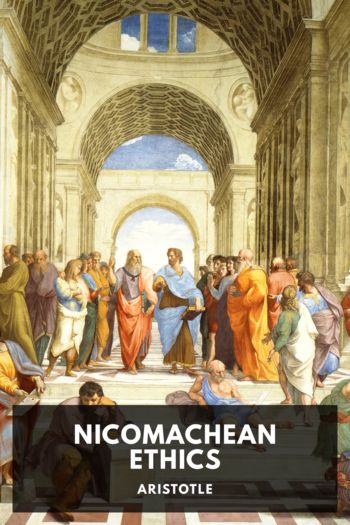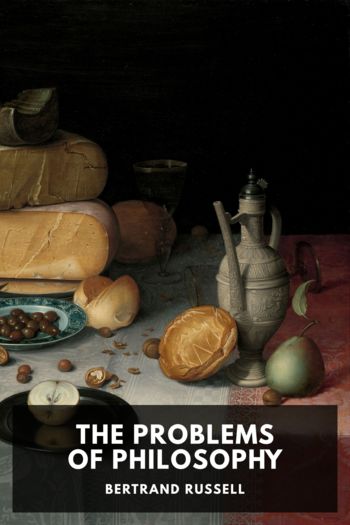The Lives and Opinions of Eminent Philosophers, Diogenes Laërtius [the gingerbread man read aloud TXT] 📗

- Author: Diogenes Laërtius
Book online «The Lives and Opinions of Eminent Philosophers, Diogenes Laërtius [the gingerbread man read aloud TXT] 📗». Author Diogenes Laërtius
But he employs a great variety of terms in order to render his philosophical system unintelligible to the ignorant. In his phraseology he considers wisdom as the knowledge of things which can be understood by the intellect, and which have a real existence: which has the Gods for its object, and the soul as unconnected with the body. He also, with a peculiarity of expression, calls wisdom also philosophy, which he explains as a desire for divine wisdom. But wisdom and experience are also used by him in their common acceptation; as, for instance, when he calls an artisan wise (σοφὸς). He also uses the same words in different senses at different times. Accordingly he uses φαῦλος in the sense of ἁπλοῦς, “simple,” in which meaning also the word occurs in Euripides, in the Licymonius, where the poet speaks of Hercules in the following terms:
Mean looking (φαῦλος), rude, virtuous in great affairs,
Measuring all wisdom by its last results,
A hero unrefined in speech.
But Plato uses the word sometimes even for what is beautiful; and sometimes for small and insignificant; and very often he uses different words to express the same idea. Accordingly, besides the word ἰδέα for a class, he uses also εἶδος, and γένος, and παράδειγμα, and ἀρχὴ, and αἴτιον. Sometimes he uses opposite expressions for the same thing; accordingly, he says that it is an object of sensation that exists, while at other times he says it is that which does not exist; speaking of it as existing because of its origin, and as nonexistent with reference to its continual changes. Then again, he defines his ἰδέα as something which is neither moving nor stationary, at one time calling the same thing, at another time one thing, at a third time many things. And he is in the habit of doing this in many instances.
And the explanation of his arguments is threefold. For first of all, it is necessary to explain what each thing that is said is; secondly, on what account it is said, whether because of its bearing on the principal point, or figuratively, and whether it is said for the purpose of establishing an opinion of his own, or of refuting the arguments brought forward by the other party to the conversation; and thirdly, whether it has been said truly.
But since there are some particular marks put in his books, we must also say something about them. × indicates peculiar expressions and figures of speech, and generally any peculiarities of Plato’s style. When doubled it points to the doctrines and peculiar opinions of Plato; ※ when dotted all round, points to some select bits of beautiful writing. When doubled and dotted it indicates corrections of some passages. A dotted obelus indicates hasty disapprovals. An inverted sigma dotted all round points out passages which may be taken in a double sense, and transpositions of words. The Ceraunium33 indicates a connection of philosophical ideas. An asterisk points out an agreement in doctrine. And an obelus marks the rejection of the expression or of the passage. These then are the marginal marks which occur, and the writings of which Plato was the author: which, as Antigonus the Carystian says, in his treatise on Zeno, when they had been but lately published, brought in some gain to the possessors, if anyone else was desirous of reading them.
These now were his chief opinions. He affirmed that the soul was immortal and clothed in many bodies successively, and that its first principle was number, and that the first principle of the body was geometry. And he defined it as an abstract idea of spirit diffused in every direction. He said also that it was self-moving and threefold. For that that part of it which was capable of reasoning was situated in the head, that that portion which was affected by passion was seated around the heart, and that which was appetitive was placed around the navel and the liver. And that it is placed in the middle of the body, and embraces it at the same time in all its parts, and that it consists of elements; and that when it is divided according to harmonic intervals it forms two connected circles, of which the inner circle is divided into six portions, and makes in all seven circles; and that this is placed on the left hand of the diameter, and situated in the interior. But the other is on the right hand of the same line; on which account, and because it is one only, it is the superior of the two. For the other is divided internally; and this too, is the circle of that which is always the same; the other, the circle of that which is changeable and different. And the one he says is the motion of the soul, but the other is the motion of the universe and of the planets.
On the other side, the division of the circles from the center to the extremities, being harmoniously appropriated to the essence of the soul, the one knows existing things and establishes harmony between them, because it is itself composed of harmonious elements. The circle of what is changeable engenders opinion by its regular movements; but the circle of that which is always the same produces knowledge.
Plato lays down two primary causes or principles of all things: God and matter, which he also calls mind





Comments (0)